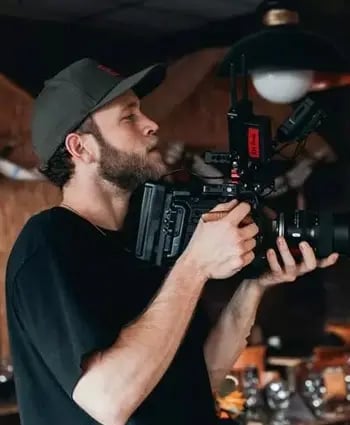6 Ways to Measure Video Performance on Wistia
Discover why Wistia's top for video hosting with advanced analytics. Learn which metrics gauge your video's impact best
 Wistia is our go-to video hosting platform at Venture. We use it for our clients' video content as well as our own, as it's specifically designed for businesses. What makes it one of the best video hosting sites on the market is its focus on data, customisation and ability to integrate with third-party services.
Wistia is our go-to video hosting platform at Venture. We use it for our clients' video content as well as our own, as it's specifically designed for businesses. What makes it one of the best video hosting sites on the market is its focus on data, customisation and ability to integrate with third-party services.
Once you publish your shiny new video on Wistia and the views begin to rush in, you'll have access to a whole host of advanced metrics and it can be overwhelming to work out which actually matter to you and how these relate to your goals. If you don't measure your video marketing properly, you can easily under-report on the value it is providing and it will quickly start to look like a bad investment.
We're going to take a look at the analytics you can use to measure performance in Wistia, what they mean and how to decide what to measure so you can truly understand the impact your video is having. Let's turn data into understanding!
But, before you start measuring success you'll need to define some things to make sure you get the most out of your metrics:
- Set your goal. What do you want your video to accomplish?
- Define your target audience. Who are you talking to? How do you want them to watch it?
- Decide which metrics to focus on. After outlining your goal and audience, you need to work out which metrics below are most important for measuring success for your video. So, let's take a look.
Metrics to measure video performance
View count
(Aka. total plays.)
If the goal is for your video to be seen by as many people as possible, then video views are a good place to start. Whilst it doesn't necessarily indicate whether your video is resonating with your audience, it does help you determine whether your video is getting the exposure you want and will help you calculate market penetration.

You can easily improve the view count on your videos, by using promotional channels such as paid advertising (e.g. social media), influencers, email marketing or optimising for search.
Video views shouldn't be something you measure in isolation as it provides a very narrow picture of success. Focusing solely on views will tell you that you should create more short, entertaining videos that don't tell your brand story. What you have to weigh up is whether having a viral video is more important for your business, than a small number of people watching a video that has a strong brand message.
However, don't completely discount them as a metric as they are a good indication of whether you are making impressions and fostering brand familiarity. We suggest you measure video views alongside a couple of other metrics depending on what your goals are and success means to you.
Engagement
(Aka. time watched.)
Engagement in the context of videos, relates to the percentage of a video that a viewer watches. It goes beyond counting how many people have viewed it, to tell you the quality of those views. Once they started watching the video did they stick around, or did they leave because of a slow hook or was the video too long?

Engagement not only shows that people are watching your video for longer, but that the video is resonating with them. However, it is important to remember that low engagement isn't always a bad thing, as the metric needs to be taken in context of your video goals. If the objective of your video is to educate or inform a viewer on a particular subject, low engagement may mean you were able to answer their question quickly and succinctly. On the other hand, if you have a post-roll call-to-action, you will want viewers to watch your video all the way through to benefit from this.
Wistia not only tells you the average engagement on your video, but the engagement graph allows you to see how your whole audience is playing your content (see below). The blue section of the graph shows audience engagement and where viewers dropped off. A steady decline is normal, but if you have sudden dips you should review that section of your video to see why this occurred.
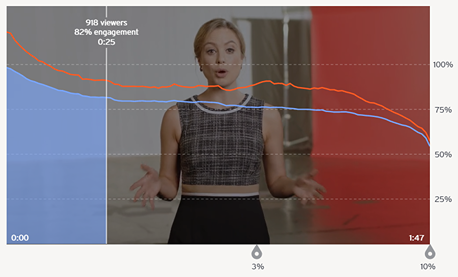
The orange section gives you visibility on where viewers rewound your video and played it multiple times. The spikes show where users found the video compelling and interesting enough to replay. This is a good indication of where you should make cut downs of your video for further distribution on social media, for example.
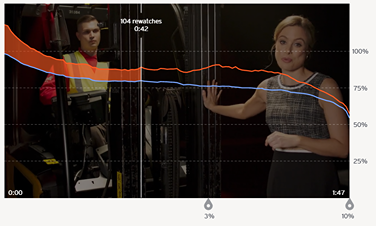
Wistia argues that "time-watched" (engagement) is the best metric to measure for video as it tells you to focus on the things that your audience has meaningfully, voluntarily engaged with. And whilst it is not a metric that can be seen through the lens of ROI, we would have to agree that it should be a core part of any video measurement, alongside other metrics that align with your goal. As Wistia puts it:
If we can grasp the concept that, as marketers, we are no longer optimizing for share of voice, (i.e. the amount of noise being made) but for share of mind (i.e. the time and consideration people are spending with your company), Time Watched reveals itself as the best possible universal video metric.
Play-rate
Play-rate measures the number of people that played your media divided by the unique visitors that came to the page as a percentage. So, put simply, how many people who visited the webpage the video is on played it. It is an indicator of relevancy and can help you determine whether your video is in the right context.

Once again, it is important to consider the purpose of the video. If it is a supporting piece of content, the play-rate is likely to be lower than a video that is central to your page. But, if the play-rate is lower than you'd like, it may be worth altering:
- The position on the website. Would it be more relevant on a different page?
- The thumbnail to a more relevant and engaging image
- The position on the page. Is it in a prominent location?
- The size of the embed. Is it obvious?
All of these elements will factor into whether visitors make the commitment to press play, so it is worth testing what has the biggest impact.
Heatmaps
Something very unique to Wistia is heatmaps, a powerful tool for measuring audience behaviour and engagement. Each viewer is assigned a heatmap which shows you a second-by-second view of how your audience watched and engaged with your video.

Heatmaps are a treasure trove of information, providing audience information, such as location, email address (if provided through a Turnstile), the time and date the video was played, and a timeline that shows how the viewer interacted with the video. You can also click into the heatmap for even more data, like the device, IP address and page it was viewed on.

If you have gated your video, heatmaps are the best and quickest way to check the pulse of an individual prospect or lead.
Heatmaps also provide a more detailed look at engagement on a video. For example, are international viewers dropping out quicker than local ones? Is your video getting more engagement at certain times? Are certain landing pages resulting in better play-rates?
Much like, engagement or time-viewed, heatmaps help you understand the relevancy of your video, diving deeper into the specifics and context of high or low engagement.
Conversions
Chances are one of the key metrics you will want to track is how many viewers are converting, whether this is signing up to your mailing list or buying your product. Wistia has a variety of "actions" you can use within your videos: lead generation, annotations and call-to-actions.
Lead generation
Video is an excellent way to drive leads and with Wistia's Turnstile email collector, it is even easier. With this feature you can collect emails directly from your video and add qualified leads to your database.
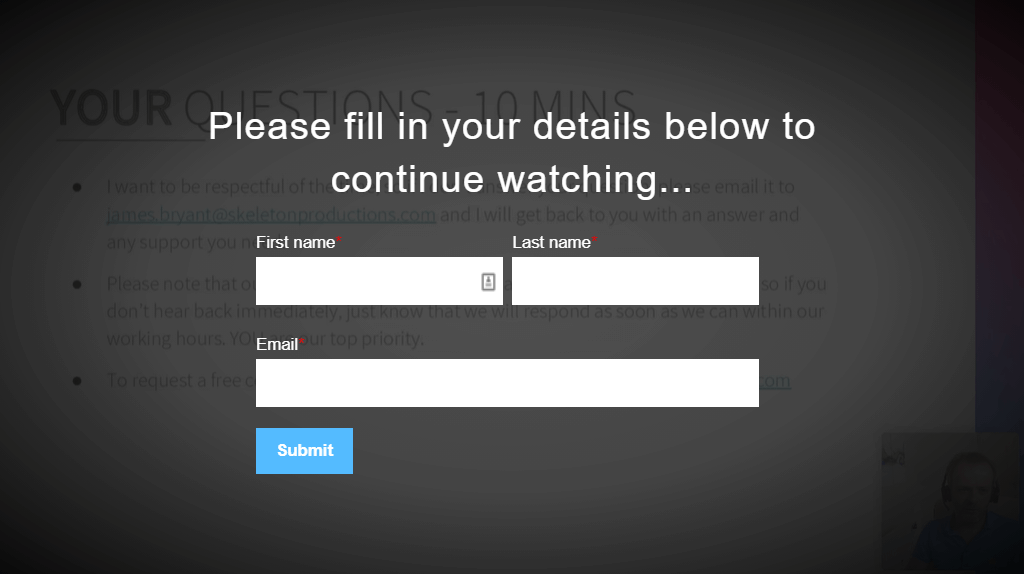
You can use the form as a gateway to the video, placing it either at the beginning so it requires viewers to enter their details to watch, or take a sales hook approach and provide some value and then ask for their email in return. Or if you want to minimise barrier to entry, you can add the form post-roll.
What's even better - Wistia can integrate with third-party platforms like Hubspot and Pardot. Making your marketing even more seamless!
To measure conversion-rate, simply look at how many leads your form is generating compared to the number of views. This will give you a good indication of how effective your content is and whether it is providing enough value to a viewer to encourage them to sign up for more.
Call-to-action
Attributing conversions or sales directly to your video is a pretty undisputable way of measuring ROI of your video content.
Wistia gives you the option of a full screen call-to-action (CTA) or an annotation link, and much like email turnstiles, it can either be placed mid-roll or post-roll. This could be used to get users to sign up for an account, drive them to a product page, add an item to their basket, or download a guide. You can either use Wistia's simple text CTA (as shown below), upload a custom image (recommended) or use HTML.
Full page call-to-action:
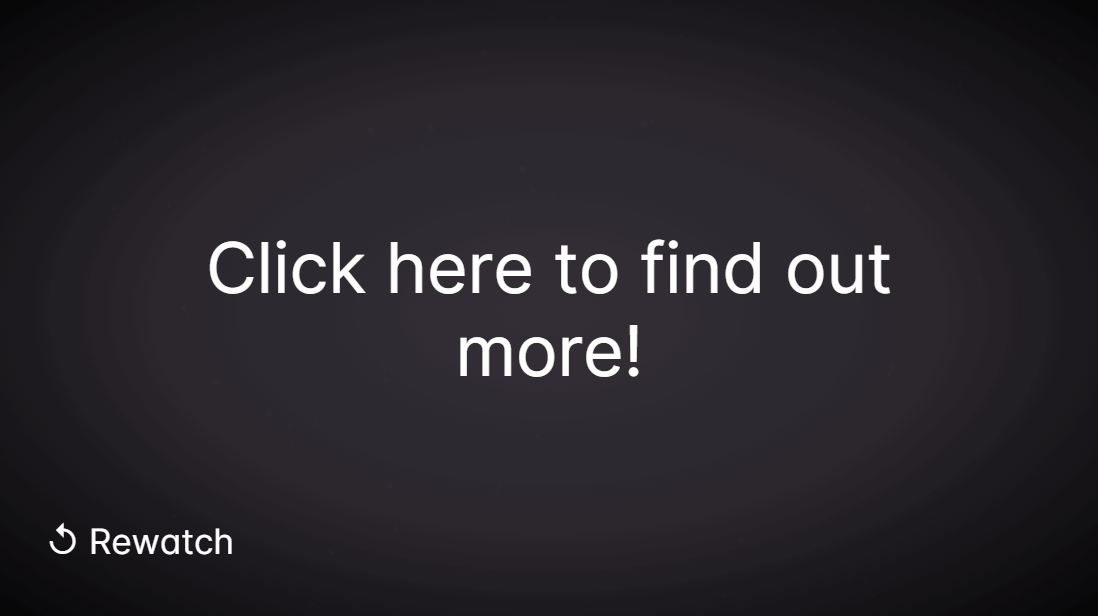
Annotation link:

In order to effectively track conversions you need to make sure you use a Google UTM link so that you can track users in Google Analytics to determine how many viewers are actually converting. You can also use cookies to track users over multiple sessions and channels, to see if they come back after watching the video to convert. This is called an "assisted conversion". If this is set up correctly, it will ensure you have a decent attribution model and can directly measure ROI.
Conversion-based measurement allows you to put a monetary value to your videos. Whilst this makes sense for certain videos, it shouldn't be a KPI you rely on for all video types. This would suggest that the goal for every video you create is to drive conversions, in other words, it is a product or sales video.
Not every video's purpose is to convert, and problems arise when this is not considered. An example being educational videos, whose purpose is to teach the viewer something. If you choose to track conversions for this video type, you run the risk of creating a video that focuses more on sales and self-promotion than what the audience is there for. This will result in decreased engagement and put viewers off.
A/B testing
Whilst this is not a metric for measuring success, A/B testing is a really useful tool
available on Wistia. It is a means to test and measure what is and isn't working and optimise your video marketing efforts.
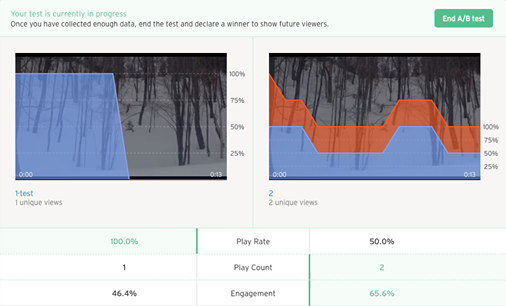
Using this tool you can test a variety of things:
Video content
- Live action vs. animation
- Video A vs. video B
- Short-form vs. long-form
Thumbnails
- Image vs. video
- Photo vs. animation
Call-to-actions
- Annotation link vs. call-to-action
- Mid-roll vs. post-roll
- Wording
The possibilities are almost endless.
You can play two videos off against each other to see which is performing best and the optimise accordingly. Within the A/B testing tool you can take a look at metrics for each video and compare which is performing best against the metrics you are determining success off.
In summary
Wistia is one of the best video hosting platforms for measuring your videos success with its advanced analytics. However, it can be too easy to get hung up on one metric or number. To really understand the impact your video is having you need to take a more holistic approach and measure a few metrics that connect with your business goals. It is important to determine what success looks like for your campaign to ensure you are actually measuring the value your video is providing.
What metrics do you use to measure your videos, performance? How have you determined these? We'd love to hear about your experience in the comments!
If you want to get more out of your videos or gain a greater understanding of your data, get in touch and we'd be happy to chat through video strategy.
Written by Jonathan English CEO for Venture Videos — a full-service video production agency that specialises in producing creative videos & campaigns that get real results.




